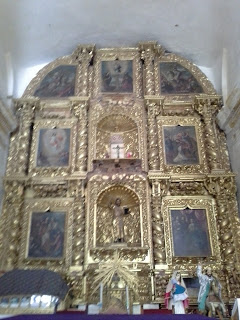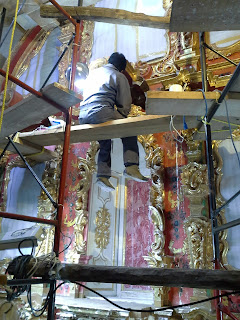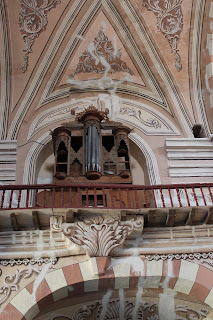Our caravan left Oaxaca shortly after 8:00 in the morning. The caravan was composed of 4 Mercedes Benz Sprinter wagons, each with 20 passenger seats. All together, there was about 70 of us that sunny Saturday morning in Oaxaca. It is mid February, and many flowers start to bloom all around the city, but they look especially radiant in the early morning sunshine.
Beautiful flowering trees along Reforma
Street in downtown Oaxaca
The 11th International Historical Organ and Old Music Festival attracted an interesting cross-section of society. The majority of the attendees were foreigners, either residing permanently in Oaxaca, or those Canadians and Americans who come down to Oaxaca every year to escape the severity of winter weather up north. There were also Americans and Canadians who had flown down to Oaxaca specifically to come to the festival. There were also the group of top notch organists and other musicians, that were invited, both from Europe and the United States.
The International Historical Organ and Old
Music Festival attracts attendees from several
countries and different walks of life.
There were also professionals that came over from Spain, that are specialists in organ repair and restoration. We also had an interesting group of young people from Mexico who have studied organ both in the National Conservatory as well as in the best schools, such as the UNAM or National Autonomous University of Mexico, who not only came to hear, but in some cases, to practice and to play on the organ. There was a proficient young female organist from Slovakia, and visitors from Colombia. There were some historians from Mexico, as well a handful of native Mexican from Oaxaca. The program was conducted in both English and Spanish, and all handouts were printed in both languages.
We made a quick pit-stop at Yanhuitlan on
the road to Tamazulapan.
After we took the toll way, 135D, going north (the one that goes to Tehuacan, and eventually to Puebla and to Mexico City) for more than 90 minutes, we took 190 that while still northbound, started veering toward the east. All of a sudden, after a turn, we saw Santo Domingo Yanhuitlan, off to the right. Cicely Winter, chairwomen of the Festival, let us take a brief stop at a convenience store, but warned that we could not visit Yanhuitlán for the moment, but we would have to wait later on in the afternoon on the way back to see it.
One of the Mercedes Benz vans in our caravan
as we stop at the main plaza of Tamazulapan
and enter into the courtyard of the church.
About 45 minutes later, we entered into the town of Tamazulapan, in the Alta Mixteca de Oaxaca. We had to hurry to enter into the Church of Santa Maria de la Natividad Tazazulapan, because we were to going to listen to our third Concert there. But what was the hurry? In in a seemingly sleepy village in the Alta Mixteca like Tamazulapan, Saturday morning is prime time for a beautiful church with the constant flow of Baptisms and First Holy Communions, as well as mid-day and early afternoon Weddings.
This triple archway leads to the atrium of the
church of Santa Maria de la Natividad
Tamazulapan
The program featured five top level organists: Christopher Holman, Jesús Gonzalez Velasco, Jeffrey Cooper, Tonatiuh González Solis, and Michael David Ging.
Coming through the gateway into the atrium
of Santa Maria de la Natividad feels on
sunny morning feels like entering Paradise.
Christopher Holman serves as the Music Associate at the Bach Society Houston and Christ the King Lutheran Church in Houston. Christopher is working on his Masters of Music degree in Organ Performance at the Moore's School of Music.
Estela stops and turns around on her way to the
concert at Santa Maria de la Natividad.
Christopher Holman played for us the Bergamasca by Girolamo Frescobaldi (1583-1643) and then the Canzona en Sol mayor by Franz Tunder (1614.1667).
A view of the atrium of Santa Maria de la
Navidad as Estela is about to enter the church.
Jesús González Velasco is from Santa Maria Tlacolula, He was granted a scholarship from the IOHIO for playing organ, and plays organ at Mass at the Tlacolula Church on Sundays. He received the Pierre-Arnaud Le Guerinel Scholarship for piano.
Sunlight beams warm up the pew
where Estela is waiting for the
concert to begin.
Jesús González Velasco played the Toccata by Emma Lou Diemer (1927-?), followed by Johann Sabastian Bach's (1685-1759) "Only God is to be praised in the heavens!" (BWV 711), and finished with Juan Cabanilles' (1644-1712) "Corrente Italiana". (The "BWV" numbers relate to the works of Johann Sebastian Bach, and BWV means Bach Werke Verseichnis which means list or index of the works of Bach. The BWV codes from 525 until 771 relate to his music for organ.)
Main aisle of Santa Maria
Natividad Tamazulapa Church
Jeffrey Cooper is a doctoral student of Robert Bates at the University of Houston. He studied previously with Graig Cramer at Notre Dame University.
The main altar and transept at
Santa Maria Natividad Tamazulapa
Jeffrey Cooper interpreted for us Inviolata (Joaquin), by Antonio de Cabezón (1510-1566).
The Blessed Virgin Mary with Saint
Dominic de Guzman, interceding
for the souls in purgatory in this
retablo or altarpiece on a side
altar in Tamazulapan.
Toantiuh González Solis is from San Isidro Huayapam, Mixes, Oaxaca. Tonatiuh studied with Gustavo Delgado Parra at the National School of Music at the National University (UNAM), graduating Magna cum Laude in 2013. He won first prize in the course "Music in Compostela" in Spain.
Altarpiece on side altar with
late Baroque style columns
Tonatiuh interpreted Girolamo Frescobaldi's (1583-1643) Cinque gagliarde del Secondo livro de Toccate. Some consider that Frescobaldi's best works come from this second book of toccate.
Altarpiece on side altar featuring
episodes of the Passion of Christ
Michael David Ging working on his doctorate with Robert Bates at the University of Houston and is the Organist-in-Residence at the New Hope Lutheran Church. He also holds degrees from Rice University and from the Oberlin Conservatory, and has received awards at the University of Alabama Organ Competition (First Prize) and Richard Van Sciver Competition.
View of the choir loft and organ
lofts on both sides.
Michael David Ging interpreted work printed in 1531 by musical editor Pierre Attaingnant (1494-1551) Dances and Canzonas from the French Renaissance of unknown composers.
The tiny Tamazulapa 2' table organ sits up on a
table, perched on the right(south) side organ loft.
The Tamazulapa church table organ is the smallest old organ found so far in Oaxaca. It is a mere 2' organ. Although small, the organ had no problem in filling the church with lovely music for the concert.
Listen to a fragment of the Concert as played
on the 2' Tamazulapan table organ, and
experience for yourself the beauty of
Baroque Music being brought back to life
in restored 18th Century instruments.
(Note: it is possible that you may experience
difficulties trying to reproduce this file on
your smartphone or tablet!)
It is exquisitely gilded and decorated with pictures on its panels of Saint Ambrose and Saint Nicholas, and of Saint Francis and Saint Anthony on the side panels.
The Tamazulapan 2' Table organ
in the right side organ loft.
The Tamazulapan table organ was manufactured sometime during the decade of the 1720's. More than being restored, the Tamazulapan organ had to be almost completely reconstructed, as so many of its original parts were missing.
This is the other unrestored
Tamazulapan organ on the left
side or Gospel side of the Church
The 2' table organ has "companion" to keep it company during the long chilly dark nights after the sacristan closes the last church door: from across the aisle, a late 18th century or early 19th century organ, but in total disarray.
View of the vault of Tamazulapa
facing the coral loft.
Another outstanding feature of Santa Maria Tamazulapa is the vault and the dome. The color combination of the cross-ribbed vault is similar in principle to many gothic structures in Umbria and in la Toscana regions during the late 1300's and 1400's, such as il Duomo di Siena, Santa Maria dei Fiori in Florence and Il Duomo di Orvieto. In the case of Italy, the combination is green and white layers of marble, and not painted plaster.
The dark interior of the Mesquite of Cordova.
However, the combination of tan and white arches in Tamazulapa are more reminiscent of Moorish architecture that the Dominican priests were exposed to in their native Spain, as we can see in the above picture of the Mesquite of Codova.
Retablo or wooden altarpiece
by Andrés de la Concha
at the main altar.
The seven column five stories high gold-leaf covered retablo at the main altar depicts many of the episodes of the life of the Blessed Virgin Mary of the Nativity, in whose honor this church was dedicated. Many of the works in the retablo were opainted by Seville-born artist Andrés de la Concha, who immigrated to la Nueva España in 1568, and was initially engaged in works in Mexico City, such as for Santo Domingo and for the old Cathedral of Mexico, some in collaboration with Simón Peryeys, before venturing down to the Alta Mixteca to work on paintings at Teposcolula, Coixtlahuaca, Achiautla and Yanhuitlán. At the top row, we see many of the Blessed Virgin's mysteries, such as her Immaculate Conception, while most of the rest of the works offer us a pictorial biography into the life of Mary, as we read it in the Gospel of Saint Luke, as many of these episodes form part of the Mysteries of the Holy Rosary: the Annunciation, the Visitation, the Nativity, the Presentation of the Infant Jesus in the Temple after 40 days otherwise known as the Purification, besides the Apparition of Our Blessed Mother in Tepeyac as the Virgin of Guadalupe, to the recently converted Indian, Juan Diego.

Chapel and Retablo dedicated
to the Passion of Christ
Retablos or wooden altarpieces are not only at the main altar, but in practically all the side altars. One smaller example is near the entrance of the Church, behind the baptismal fountain.
The dome of Tamazulapan
Why is the retablo or altarpiece of the main altar of Tamazulapan so bright and well-lit? This natural illumination is the result of large windows high up on the side wall, as well as the octagonal dome decorated with bright-colored frescos. In the four spandrels appears the four evangelists: Saint Mathew, Saint Mark, Saint Luke and Saint John.
The floor tiles of Santa Maria Tamazulapa
The aesthetic beauty of Santa Maria Tamazulapa is present in every detail of the church. During a pause during the concert, I glanced down at the floor, and whispered to Estela, "Wow, did you see the floor tiles!" Ceramics have played a major role in the decorations of Churches and homes, since the beginning of the Colonial period of the Nueva España (1521-1821), when shops in Puebla started making counterfeit Talavera tiles in their kilns, until the Viceroy gave in, accepted their de facto existence, and levied tariffs on their production, part of which was sent back to the coffers of the Spanish crown to offset the revenues that the King was losing on the sale of the authentic made-in-Spain Talavera.
Fountain decorated with blue and
white "talavera" hand-made tiles
This is the typical 6"x6" tiles you can find in old casonas or one-story houses built during the 19th Century and that were made out of "adobe" or thatched straw-and-mud bricks, with thick layers of plasters and whitewashed on the outside.
The stone-carved principle archway entrance to
the Cathedral of Oaxaca is a fine example of
nature motifs to be found in art in this region.
Notice that the floor tiles continue with the naturalistic motifs of flowers and plants which permeate retables, paintings, ceramics, stone-carved arches, window and door frames as well as water fountains, in shapes alluding to the Cross of Christ, and with the Tonatiuh (the sun) in the center.
The kiosko in the middle of the central garden
or town square of Tamazulapa
After our memorable visit to the church or Santa Maria Natividad Tamazulapa, we exited the atrium, and crossed the street to the town square, and under the shade of ancient trees and sitting beside the central kiosko, we had lunch: delicious tortas or sandwiches, made by a local woman, with ham, cheese and refried beans.
City Hall, Tamazulapa, Oaxaca, with 23 arches,
three in the middle and 10 arches on each side.
After lunch, we set off for Santiago Teolongo, to visit another dilapidated organ, in need of repair, in a church which is going through a major restoration.



































































